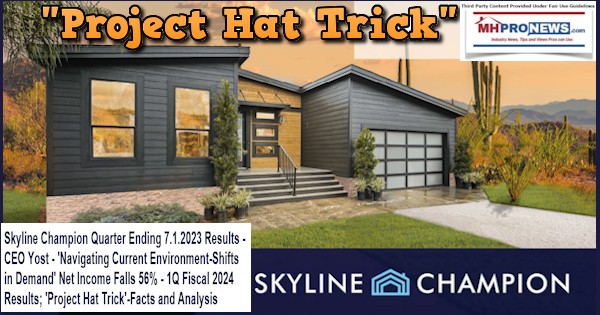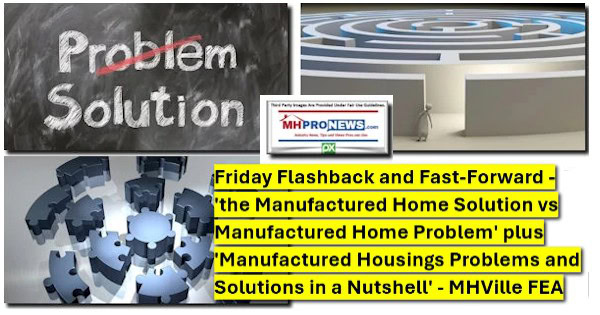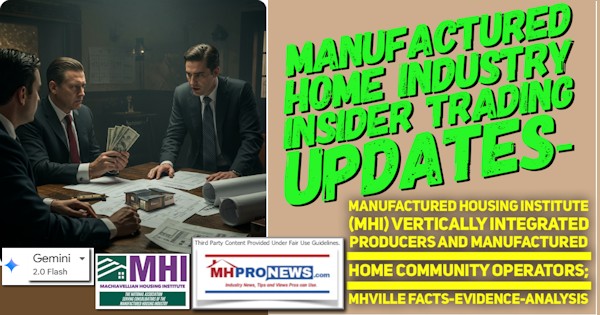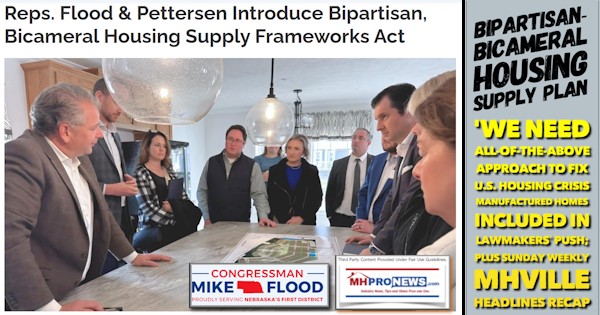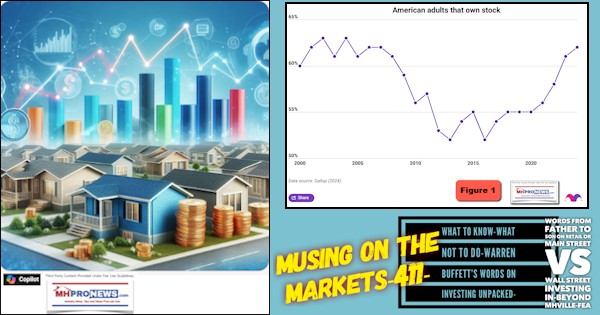
“Defendants, the United States Department of Energy and Jennifer M. Granholm, Secretary of Energy, hereby move…for dismissal of this action for lack of subject matter jurisdiction because this case is not currently ripe for adjudication.” So says the pleadings by federal attorneys working for the U.S. Department of Energy (DOE) and Secretary Jennifer M. Granholm, which is asking the court to dismiss the MHI-TMHA legal action regarding what the industry trade groups admit is a harmful DOE energy rule. The text of that document and the pleadings themselves are provided herein, along with some related information and comments in Part II. Those Part II remarks will include observations from an attorney about the DOE motion. Part II will look at topics linked to MHI CEO Lesli Gooch, Ph.D. That is paired with the DOE case for reasons that will become more apparent in Part II further below.
Additionally, others involved in MHI and previous comments made on behalf of MHI that MHI could have acted years ago to head off the current difficulties with regards the DOE and other MHVille issues will be examined. Why? Because there is evidence that MHI knew what was coming with the DOE. They could have headed this off more effectively years ago. So why didn’t MHI and its leaders do so?
Who in MHVille benefits from this regulatory stress? It has been said that the ‘devil is in the details.’ A surface skim of the following will not, by definition, reveal the purportedly devilish details that will be highlighted. Again, that and more will be revealed in Part II of this report.
Part III is our MHProNews‘ segment which looks at the Daily Business News of the broader U.S. markets, along with the market-movements of manufactured home specifically linked companies, and the left-right headlines recap.
As periodic critics of Warren Buffett, we nevertheless believe that Buffett has over the years made several keen points that are useful to millions. Among them is the value of reading daily for a depth of understanding on topics of interest and importance to professionals, investors, and others. Facts, history, details, and the trail of evidence all paint a picture that speaks loudly to those who are interested in arriving at an honest understanding of why and how manufactured housing is underperforming during a well-documented affordable housing crisis.

Part I
IN THE UNITED STATES DISTRICT COURT
FOR THE WESTERN DISTRICT OF TEXAS
AUSTIN DIVISION

DEFENDANTS’ MOTION TO DISMISS
TABLE OF CONTENTS
STATEMENT………………………………………………………………………………………………………………… 1
INTRODUCTION ………………………………………………………………………………………………………….. 1
BACKGROUND ……………………………………………………………………………………………………………. 2
I. The Energy Independence and Security Act of 2007……………………………………………………………………………………………………… 2
The Energy Conservation Standards for Manufactured Homes………………………………………………… 3
III. History of Present Litigation and Compliance Delay Rule………………………………………………………. 5
IV. Plaintiffs’ First Amended Complaint ………………………………………………………………………….. 6
LEGAL STANDARDS……………………………………………………………………………………………………. 7
ARGUMENT ………………………………………………………………………………………………………………… 7
- Plaintiffs’ Claims are Not Fit for Judicial Decision…………………………………………………………………… 9
- Plaintiffs Will Not Suffer Hardship in the Absence of Judicial Review……………………………………….. 12
CONCLUSION …………………………………………………………………………………………………………….. 14
STATEMENT
Defendants, the United States Department of Energy and Jennifer M. Granholm, Secretary of Energy, hereby move pursuant to Rule 12(b)(1) of the Federal Rules of Civil Procedure for dismissal of this action for lack of subject matter jurisdiction because this case is not currently ripe for adjudication.
INTRODUCTION
Plaintiffs, the Manufactured Housing Institute (“MHI”) and the Texas Manufactured
Housing Association (“TMHA”), seek a declaration that a rule establishing Energy Conservation
Standards for Manufactured Housing (“Standards Rule”) promulgated by the Department of Energy (“DOE”) violates the Administrative Procedure Act (“APA”). Plaintiffs also request that the Court enjoin DOE from implementing or enforcing any aspect of the Standards Rule. Plaintiffs argue that the Standards Rule is both arbitrary and capricious and contrary to the Energy Independence and Security Act of 2007 (“EISA”) because, among other things, DOE failed to establish testing, compliance, and enforcement procedures and, as a result, failed to consider related costs in its economic analysis.
Plaintiffs’ claims are not ripe because they seek relief from a rule that is not yet mandatory and from enforcement and compliance mechanisms that do not yet exist. As this Court is aware, DOE has delayed manufacturer compliance with the Standards Rule so that it can engage in further rulemaking to establish enforcement procedures. That rulemaking will clarify how manufacturers must demonstrate compliance, set forth procedures for how DOE will enforce noncompliance, and address the estimated costs associated with those procedures—some of the very issues that Plaintiffs want this Court to decide now, before DOE itself has determined and explained its procedures. Permitting DOE to complete its rulemaking process would, therefore, significantly advance the Court’s ability to review Plaintiffs’ claims by providing a more concrete setting, allowing the Court to avoid entangling itself in abstract disagreements fueled by Plaintiffs’ speculations regarding how DOE may evaluate and enforce manufacturer compliance with the
Standards Rule’s requirements. As such, Plaintiffs’ claims are not currently fit for judicial review.
Moreover, delay of mandatory compliance with the Standards Rule until after DOE promulgates its compliance and enforcement procedures ensures that Plaintiffs’ members will not suffer any hardship during the pendency of DOE’s forthcoming rulemaking. Because the Standards Rule is not being enforced, Plaintiffs do not have to choose between complying with a set of regulations they believe to be unlawful or risking potential civil liability for noncompliance.
Having this Court decide Plaintiffs’ claims now, before DOE has completed its rulemaking process, would interfere with the agency’s regulatory process—a process that, if allowed to proceed on its own, may resolve some of Plaintiffs’ concerns. At a minimum, DOE’s rulemaking will clarify issues for more intelligent resolution. Withholding judicial consideration of Plaintiffs’ claims would also preserve the resources of both the Court and the parties by avoiding piecemeal litigation on matters that may be superseded by subsequent agency action. Because the Standards Rule is not being enforced prior to subsequent rulemaking from DOE, there is no harm to Plaintiffs in waiting for that rulemaking to be completed. This case should be dismissed.
BACKGROUND
I. The Energy Independence and Security Act of 2007
Congress enacted EISA in 2007 to increase the energy efficiency of products and buildings, including manufactured homes. Pub. L. 110-140, tit. IV, subtit. A, § 413, 121 Stat. 1492, 1601 (Dec. 19, 2007) (codified at 42 U.S.C. § 17071(a)(1)). Manufactured homes are constructed in accordance with Federal construction standards administered by the U.S. Department of Housing
2
and Urban Development (“HUD”). See 24 C.F.R. pt. 3280. EISA, however, directs the Secretary of Energy, rather than HUD, to “establish standards for energy efficiency in manufacturing housing” after both “notice and an opportunity for comment” by stakeholders and consultation with HUD. 42 U.S.C. §§ 17071(a)(1)-(2). HUD, in turn, may seek counsel from the Manufactured Housing Consensus Committee (“MHCC”). Id. EISA further requires the energy conservation standards:
be based on the most recent version of the International Energy Conservation Code [(“IECC”)] (including supplements), except in cases in which the Secretary finds that the code is not cost-effective, or a more stringent standard would be more cost effective, based on the impact of the code on the purchase price of the manufactured housing and on total life-cycle construction and operating costs.
Id. § 17071(b)(1) (footnote omitted).
In establishing the standards, the Secretary may consider “design and factory construction techniques[,]” base the standards on “the climate zones established by [HUD,]” and “provide for alternative practices that result in net estimated energy consumption equal to or less than the specific standards.” Id. §§ 17071(b)(2)(A)-(C). EISA requires the standards to be updated within one year following “any revision” to the IECC. Id. § 17071(b)(3)(B). The IECC is generally “revised every three years.” Sierra Club v. Perry, 373 F. Supp. 3d 128, 132 (D.D.C. 2019) (citation omitted).
II. The Energy Conservation Standards for Manufactured Homes
Pursuant to EISA’s directive, in May 2022, after a long and careful rulemaking, DOE promulgated a tiered set of energy conservation standards for manufactured homes based on the
2021 IECC. See Energy Conservation Program: Energy Conservation Standards for Manufactured Housing, 87 Fed. Reg. 32,728 (May 31, 2022), codified at 10 C.F.R. pt. 460; see also Defs.’ Mem. in Opp’n to Pls.’ Mot. to Stay Agency Action, 4-5, ECF No. 32 (summarizing rulemaking history). The Standards Rule mandated compliance on and after May 31, 2023. 87
3
Fed. Reg. 32,728. Under the rule, the stringency of the requirements for each tier depends on the number of sections of the manufactured home. Id. at 32,730. Both Tier 1 and Tier 2 incorporate building thermal envelope components subject to the 2021 IECC that DOE determined applicable and appropriate for manufactured homes. Id. Tier 1 applies these building thermal envelope provisions to single-section homes at stringencies that would increase the purchase price by less than $750 in order to address affordability concerns raised by HUD. Id.; see also id. at 32,742-43. Tier 2 applies these same provisions to multi-section homes but at higher stringencies specified in the 2021 IECC, with an alternative exterior wall insulation requirement (R-21) for HUD climate zones 2 and 3. Id. at 32,730. Standards for both tiers include provisions addressing duct and air sealing, insulation installation, HVAC and service hot water system specifications, mechanical ventilation fan efficacy, and heating and cooling equipment sizing. Id.
DOE determined the standards for both Tier 1 and Tier 2 homes are cost effective when evaluating the impact of the standards on both the purchase price and on the total 30-year lifecycle construction and operation costs. See id. at 32,735; see also 42 U.S.C. § 17071(b). Additionally, DOE concluded that the benefits realized by the standards, including energy savings and emission reductions, outweigh the burdens. See 87 Fed. Reg. at 32,735.
Manufacturers may comply with the standards by using one of two methods: the prescriptive method, which uses the components specified by DOE, or the performance method, which allows for compliance based on the overall thermal transmittance performance of the home. Id. at 32,741. Although the Standards Rule does not establish procedures for either DOE’s evaluation of compliance or enforcement of noncompliance, DOE noted that “many of the requirements in the standards would require minimal compliance efforts[,]” such as documenting the use of materials already subject to separate Federal or industry standards, and thus impose
4
“minimal additional costs.” Id. at 32,758. DOE further noted that it would continue to consult with HUD regarding potential approaches for compliance and enforcement “that may leverage the existing HUD inspection and enforcement process to ensure manufacturer compliance with the standards” is “not overly burdensome or costly[.]” Id.; see also id. at 32,743. Finally, DOE stated that it would consider the comments it had received about compliance and enforcement issues,
“including an analysis of any related costs,” in a future agency action. Id. at 32,757-58.
III. History of Present Litigation and Compliance Delay Rule
Plaintiffs filed this lawsuit on February 14, 2023, alleging that the Standards Rule is both arbitrary and capricious and contrary to law and thus violates the APA because it: (1) imposes an unreasonable one-year window for compliance; (2) mandates compliance before DOE establishes testing procedures or a compliance and enforcement scheme; (3) fails to consider any costs relating to testing procedures or a compliance and enforcement scheme; (4) fails to consider the actual cost of compliance due to current economic conditions, thereby failing to consider whether the standards will greatly impact the purchase price, as well as the total life-cycle construction and operation costs of homes; and (5) is the result of DOE’s failure to meaningfully consult with HUD.
See Compl. ¶¶ 114-117, 122-28, ECF No. 1. On that same day, Plaintiffs moved for a stay of the May 31, 2023, compliance date. See Pls.’ Mot. to Stay Agency Action, ECF No. 5.
On March 24, 2023, DOE published a Notice of Proposed Rulemaking (“NOPR”) to delay the Standards Rule’s May 31, 2023, compliance date in order to provide the agency with additional time to establish enforcement procedures that would provide clarity to manufacturers and other stakeholders regarding how DOE would evaluate compliance and the procedures DOE would use to enforce the standards. See Energy Conservation Program: Energy Conservation Standards for Manufactured Homes; Extension of Compliance Date, 88 Fed. Reg. 17,745 (Mar. 24, 2023). DOE
5
published a final rule on May 30, 2023, delaying the compliance date until, for Tier 1 homes, 60 days after issuance of enforcement procedures, and, for Tier 2 homes, until July 1, 2025. Energy Conservation Program: Energy Conservation Standards for Manufactured Housing; Extension of Compliance Date, 88 Fed. Reg. 34,411 (May 30, 2023) (“Delay Rule”). DOE approximates that it will publish a NOPR setting forth its proposed enforcement procedures in or before February
- See Office of Management and Budget, Office of Information and Regulatory Affairs,
Unified Agenda, Energy Conservation Program: Energy Conservation Standards for Manufactured Housing; Enforcement Procedures, RIN 1904-AF54,
https://www.reginfo.gov/public/do/eAgendaViewRule?pubId=202304&RIN=1904-AF54 (last visited Sept. 23, 2023).
In light of the Delay Rule, the parties agreed Plaintiffs’ motion to stay the compliance date was moot. See Joint Advisory ¶ 5, ECF No. 42. Plaintiffs subsequently amended their Complaint on August 11, 2023. See Pls.’ First Am. Compl. Seeking Permanent Declaratory & Injunctive Relief Under the APA, ECF No. 48.
IV. Plaintiffs’ First Amended Complaint
Plaintiffs’ First Amended Complaint largely tracks their original Complaint. Indeed, in summarizing the First Amended Complaint, Plaintiffs explain that “[o]ther than Plaintiffs’ challenge to the . . . May 31, 2023 compliance date . . . all substantive defects to the Final Rule as addressed in Plaintiffs’ original complaint . . . remain.” First Am. Compl. ¶ 1. Plaintiffs claim that the Standards Rule is both arbitrary and capricious and contrary to law because DOE failed to (1) consider the costs related to testing procedures or compliance and enforcement; (2) account for the actual costs necessary to comply with the Final Rule due to current economic conditions; (3) ensure manufactured housing remains affordable for low-income purchasers; and (4) meaningfully
6
consult with HUD. First Am. Compl. ¶¶ 114-16, 122-25. Plaintiffs seek a declaration that the Standards Rule is invalid in its entirety and an injunction prohibiting DOE from implementing or enforcing any aspect of the Standards Rule. Id., Prayer for Relief (a)-(b).
LEGAL STANDARDS
Federal Rule of Civil Procedure 12(b)(1) requires dismissal of a complaint where “the court lacks the statutory or constitutional power to adjudicate the case.” Walmart Inc. v. U.S. Dep’t of Justice, 21 F.4th 300, 307 (5th Cir. 2021) (citation omitted). “Article III of the United States Constitution provides that federal courts have the power to decide only actual cases or controversies.” Choice Inc. of Tex. v. Greenstein, 691 F.3d 710, 714-15 (5th Cir. 2012) (citing U.S. Const. art. III, § 2). “The justiciability doctrines of standing, mootness, political question, and ripeness ‘all originate in Article III’s ‘case’ or ‘controversy’ language.’” Id. at 715 (citation omitted). “The plaintiff[s], as the party asserting jurisdiction, bears the burden of proof.” Id. at 714. “In assessing jurisdiction, the district court is to accept as true the allegations and facts set forth in the complaint.” Id. “Additionally, ‘the district court is empowered to consider matters of fact which may be in dispute.’” Id. (quoting Ramming v. United States, 281 F.3d 158, 161 (5th Cir. 2001)).
ARGUMENT
Plaintiffs’ claims are not ripe for judicial review. “At its core, ripeness is a matter of timing that serves to prevent courts from entangling themselves in cases prematurely.” Walmart, 21 F.4th at 312 (citation omitted). “The ripeness doctrine’s basic rationale is ‘to prevent the courts, through avoidance of premature adjudication, from entangling themselves in abstract disagreements over administrative policies[.]’” Ohio Forestry Ass’n, Inc. v. Sierra Club, 523 U.S. 726, 732-33 (1998) (quoting Abbott Lab’ys v. Gardner, 387 U.S. 136, 148 (1967)). The ripeness doctrine also
7
“‘protect[s] . . . agencies from judicial interference until an administrative decision has been formalized and its effects felt in a concrete way by the challenging parties.’” Id. at 733 (quoting Abbott Lab’ys, 387 U.S. at 148-49). Accordingly, “[i]f [a] purported injury is ‘contingent on future events that may not occur as anticipated, or indeed may not occur at all,’ the claim is not ripe for adjudication.” Lopez v. City of Hous., 617 F.3d 336, 342 (5th Cir. 2010) (alteration omitted) (quoting Thomas v. Union Carbide Agric. Prods. Co., 473 U.S. 568, 580-81 (1985)). “For these reasons, a ripeness inquiry is often required when a party is seeking[,]” as Plaintiffs seek here,
“pre-enforcement review of a law or regulation.” Roark & Hardee LP v. City of Austin, 522 F.3d 533, 544 (5th Cir. 2008) (emphasis in original).
“A declaratory judgment action is ripe for adjudication only where an ‘actual controversy’ exists.” Walmart, 21 F.4th at 311 (quoting Orix Credit All., Inc. v. Wolfe, 212 F.3d 891, 896 (5th Cir. 2000)); see also United Transp. Union v. Foster, 205 F.3d 851, 857 (5th Cir. 2000) (“Declaratory judgments are typically sought before a completed ‘injury-in-fact’ has occurred . . . but still must be limited to the resolution of an ‘actual controversy.’”) (citation omitted). “Whether an actual controversy exists must be determined on a case-by-case basis, but ‘[a]s a general rule, [one] exists where ‘a substantial controversy of sufficient immediacy and reality [exists] between parties having adverse legal interests.’” TOTAL Gas & Power N. Am., Inc. v. FERC, 859 F.3d 325, 333 (5th Cir. 2017) (quoting Orix Credit All., 212 F.3d at 896). To determine whether an actual controversy exists such that a declaratory judgment action is ripe for adjudication, courts conduct “a twofold inquiry[,] . . .‘evaluat[ing] both the fitness of the issues for judicial decision and the hardship to the parties of withholding court consideration.’” Walmart, 21 F.4th at 311 (quoting Abbott Lab’ys, 387 U.S. at 149). Both prongs must be satisfied for a declaratory judgment action to be ripe for judicial review. “Unsuitability for review is determinative.” Huawei Techs.
8
USA, Inc. v. FCC, 2 F.4th 421, 435 n.30 (5th Cir. 2021) (citation omitted). Similarly, a court need not “address the fitness of the issues for judicial decision” where a plaintiff “has not satisfied the hardship prong of the ripeness inquiry.” Choice Inc. of Tex., 691 F.3d at 718. Plaintiffs’ claims fail to satisfy either prong.
I. Plaintiffs’ Claims are Not Fit for Judicial Decision
“[I]n the context of pre-enforcement agency action there are several established factors” courts must consider when evaluating the “fitness for decision[,]” prong “including ‘whether the issue presented is a purely legal one, whether consideration of that issue would benefit from a more concrete setting, and whether the agency’s action is sufficiently final.’” Walmart, 21 F.4th at 311 (quoting Ciba-Geigy Corp. v. EPA, 801 F.2d 430, 435 (D.C. Cir. 1986). “Failure on even one of the three prongs can render a case unfit for judicial review.” Id. (citing Nat’l Park Hospitality Ass’n v. U.S. Dep’t of Interior, 538 U.S. 803, 812 (2003)).
It is without question that Plaintiffs’ claims present purely legal issues. See Cement Kiln Recycling Coal v. EPA, 493 F.3d 207, 215 (D.C. Cir. 2007) (“It is well established that claims that an agency’s action is arbitrary and capricious or contrary to law present purely legal issues.”) (alteration and citation omitted). Nevertheless, Plaintiffs’ claims are not fit for judicial decision because “allowing more time for development of events would significantly advance [the Court’s] ability to deal with the legal issues presented or aid [the Court] in their resolution.” Roman Cath. Diocese of Dall. v. Sebelius, 927 F. Supp. 2d 406, 425 (N.D. Tex. 2013) (quoting Doe v. Bush, 323 F.3d 133, 138 (1st Cir. 2003)); see also Nat’l Park Hospitality Ass’n, 528 U.S. at 812.
Plaintiffs’ claims include allegations that DOE failed to consider the “costs related to testing procedures or compliance and enforcement” and the “impact” of those costs on the “‘purchase price of manufactured housing and on total life-cycle construction and operation
9
costs.’” First Am. Compl. ¶ 114 (quoting 42 U.S.C. § 17071(b)(1)); see also id. ¶ 122. Although DOE stated in the Standards Rule that “many of the requirements in the standards would require minimal compliance efforts[,]” such as documenting the use of materials already subject to separate Federal or industry standards, and thus impose “minimal additional costs[,]” the Department indicated it would establish formal compliance and enforcement procedures in a future agency action. 87 Fed. Reg. at 32,758.
As the Court is aware, DOE recently delayed the Standards Rule’s compliance date so that it could engage in rulemaking to supplement the Standards Rule to include provisions addressing how DOE will evaluate manufacturer compliance with the standards and enforce noncompliance. See 88 Fed. Reg. 34,411; see also id. at 34,418 (reserving new subpart D of part 460 for forthcoming enforcement procedures). Development of compliance and enforcement procedures will necessarily include, as DOE noted in the Standards Rule, consideration of “any related costs[.]” 87 Fed. Reg. at 32,757. DOE’s forthcoming rulemaking, therefore, will clarify the Department’s position regarding issues relating to testing, compliance, enforcement, and associated costs.
Considering Plaintiffs’ claims regarding those issues now, without the benefit of DOE’s clarified position, would embroil the Court in the type of “abstract disagreements” the ripeness doctrine is designed to prevent. Ohio Forestry Ass’n, 523 U.S. at 732-33 (citation omitted). For example, Plaintiffs contend that the Standards Rule will require “[t]esting . . . to determine whether manufactured homes meet [duct system] leakage requirements” and that such testing “could cost approximately $1500 per home[.]” First Am. Compl. ¶ 77. But the Standards Rule does not require such testing. See, e.g., 87 Fed. Reg. at 32,757. Plaintiffs’ assertions are nothing more than speculation at this juncture; the forthcoming enforcement rulemaking will address how
10
manufacturer compliance will be evaluated. See 88 Fed. Reg. at 34,411, 34,418. That rulemaking may require duct system leakage testing—or it may not. If duct system leakage testing is required, DOE’s analysis may estimate that it costs $1500 per home—or it may not. Postponing consideration of Plaintiffs’ claims until after DOE completes the forthcoming rulemaking would allow the Court to resolve those issues in the context of a concrete—not hypothetical—dispute.
Postponing review of Plaintiffs’ claims would also advance the ripeness doctrine’s other interest—protecting agencies such as DOE from “judicial interference until an administrative decision has been formalized and its effects felt in a concrete way by the challenging parties.” Ohio Forestry Ass’n, 523 U.S. at 733 (citation omitted). Consideration of Plaintiffs’ claims regarding testing, compliance, enforcement, and associated costs now would run counter to this interest by denying DOE an opportunity to determine and explain its procedures for evaluating manufacturer compliance with the standards and enforcing noncompliance, as well as an opportunity to apply its expertise to the analysis of any associated costs.
Finally, postponing consideration of Plaintiffs’ claims would serve the interests of judicial economy. In addition to “solidify[ing] or simpl[ifying] the factual context” of the dispute between the parties, “permitting [DOE’s] administrative process to reach its end” may resolve some of Plaintiffs concerns, particularly with respect to testing, compliance, enforcement, and associated costs, thereby “narrow[ing] the legal issues at play, [which in turn] allow[s] for more intelligent resolution of any remaining claims[.]” Am. Petroleum Inst. v. EPA, 683 F.3d 382, 387 (D.C. Cir. 2012). It would also “avoid[] inefficient and unnecessary piecemeal review,” id., which “would contravene sound policies favoring judicial and administrative economy.” Pennzoil Co. v. FERC, 742 F.2d 242, 245 (5th Cir. 1984). Accordingly, because consideration of Plaintiffs’ claims will
11
benefit from further development of events, Plaintiffs’ claims are not fit for judicial decision. See Nat’l Park Hospitality Ass’n, 538 U.S. at 812.
II. Plaintiffs Will Not Suffer Hardship in the Absence of Judicial Review
“The Supreme Court has found hardship to inhere in legal harms, such as the harmful creation of legal rights or obligations; practical harms on the interests advanced by the party seeking relief; and the harm of being ‘force[d] . . . to modify [one’s] behavior in order to avoid future adverse consequences.” Texas v. U.S., 497 F.3d 491, 499 (5th Cir. 2007) (quoting Ohio
Forestry Ass’n, 523 U.S. at 734); see also Choice Inc. of Tex., 691 F.3d at 715 (citations omitted).
Whether these legal harms rise to the level of hardship warranting judicial review, however,
“depends” on the “degree” of the challenged “regulation’s present effect on those seeking relief.” Toilet Goods Ass’n, Inc. v. Gardner, 387 U.S. 158, 164 (1967). Stated differently, “to constitute a hardship, the impact of the [challenged] regulations must be ‘sufficiently direct,’ resulting in an ‘immediate and significant change in the plaintiffs’ conduct.’” Roman Cath. Diocese of Dall., 927
- Supp. 2d at 426 (quoting Abbott Lab’ys, 387 U.S. at 152-53); see also Roark & Hardee LP, 522 F.3d at 545 (hardship demonstrated “[w]here a regulation requires an immediate and significant change in the plaintiffs’ conduct of their affairs”) (citation omitted).
There is no question that, once DOE completes the forthcoming enforcement rulemaking and the compliance dates are fully known, manufacturers will have to modify their operations to avoid the legal consequences that will flow from noncompliance with the standards. See 42 U.S.C. § 17071(c). But at present, as the foregoing discussion demonstrates, the Standards Rule imposes no immediate legal obligation upon manufacturers to alter their operations. The Delay Rule provides manufacturers a reprieve from having to modify their operations until after DOE completes the forthcoming rulemaking. See 88 Fed. Reg. 34,418 (amending the Standards Rule’s
12
compliance date to “60 days after promulgation of DOE’s forthcoming enforcement procedures for Tier 1 homes, and until July 1, 2025, for Tier 2 homes”). Even upon completion of the forthcoming rulemaking on enforcement procedures, manufacturers would only face compliance obligations for Tier 1 homes initially, as Tier 2 compliance will not begin until July 2025. The Delay Rule also ensures that manufacturers will have the benefit of the clarification DOE intends to provide regarding how compliance will be evaluated, which will inform manufacturers’ decisions regarding what steps they need to take to come into compliance with the standards. See id. at 34,413 (“Delaying the compliance date until after the enforcement procedures are issued provides manufacturers time to understand DOE’s enforcement procedures and prepare their operations to ensure compliance with DOE’s standards.”). Until DOE promulgates compliance and enforcement procedures, manufacturers do not have to choose between altering their operations or risking potential civil liability once compliance with the standards becomes mandatory. Consequently, “no direct dilemma or Hobson’s choice is faced by Plaintiff[s’ members] now.” Roman Cath. Diocese of Dall., 927 F. Supp. 2d at 427; see also Choice Inc. of Tex., 691 F.3d at 716 (observing that “[t]he presence of such a dilemma has been a central feature of cases in which the hardship prong of the ripeness inquiry was held to be satisfied on modification-of-behavior grounds”).
In the meantime, Plaintiffs will have an opportunity to participate in DOE’s development of the compliance and enforcement procedures by providing comments on DOE’s forthcoming proposal. See 88 Fed. Reg. 34,413 (“DOE will provide notice and opportunity for stakeholders to comment on its enforcement procedures in the rulemaking process[.]”); id. at 34,415 (“DOE encourages commenters to participate in [enforcement procedures] rulemaking and provide feedback to the Department.”). If, after DOE promulgates its compliance and enforcement
13
procedures, Plaintiffs have any remaining claims, they will be able to raise them then. Plaintiffs will not, therefore, suffer any hardship by delaying judicial consideration of their claims until after
DOE completes the forthcoming rulemaking.
CONCLUSION
For the foregoing reasons, Plaintiffs’ claims that the Standards Rule violates the APA because it is arbitrary and capricious and contrary to law are not ripe for judicial review. The Court should accordingly dismiss Plaintiffs’ First Amended Complaint for lack of subject matter jurisdiction.
Dated: September 26, 2023 BRIAN M. BOYNTON
Principal Deputy Assistant Attorney General
BRAD P. ROSENBERG
Special Counsel
/s/ Kristina A. Wolfe
KRISTINA A. WOLFE (VA Bar No. 71570)
Senior Trial Counsel
U.S. Department of Justice
Civil Division, Federal Programs Branch
P.O. Box 883, Ben Franklin Station
Washington, DC 20044
Tel: (202) 353-4519; Fax: (202) 616-8470
Email: Kristina.Wolfe@usdoj.gov
14
CERTIFICATE OF SERVICE
On September 26, 2023, I electronically submitted the foregoing document with the clerk of court for the U.S. District Court, Western District of Texas, using the electronic case filing system of the court. I hereby certify that I have served all counsel and/or pro se parties of record electronically or by another manner authorized by Federal Rule of Civil Procedure 5(b)(2).
/s/ Kristina A. Wolfe
Part II – Additional Information with More MHProNews Analysis and Commentary
1) The PDF of the DOE motion to dismiss pleadings above are found at this link here. That linked document should be considered the official version of their motion, because cutting and pasting into website software may cause a formatting or other glitch. While MHProNews makes a reasonable effort to spot and correct those, as in all articles, it is the readers responsibility to double check from source materials, especially when MHProNews routinely provides them.
2) Per an attorney who asserts knowledge of the issues is the following emailed to MHProNews. The ellipsis […] below edit out items that might be used to identify the source of the off-the-record remarks. MHProNews edited in bracketed remarks [i.e.: DOE]

As attentive, daily, and detail minded readers of MHProNews learned yesterday, MHI knew that this day could come when the energy standards could hit – and harm – the manufactured home industry and our industry’s consumers. Per testimony on March 22, 2016 to Congress by F.R. “Jayar” Daily for MHI, that longtime executive for American Home Star said the following.

Daily said that he (and MHI) supported HR 3135 from the 114th Congress. Per GovInfo on that bill is the following.
| 07/21/2015 [last action] | Introduced in House |
But where was the Senate companion bill to HR 3135 from the 114th Congress?
Everyone who has watched the old ABC cartoons called School House Rock, or those who took good civics classes and learned how the federal legislative system works, knows that it is necessary to have essentially identical bills pass the House and the Senate in order advance to the desk of the President of the United States, where if signed, a bill becomes law.
Gov Info stated this as the history of the MHI supported bill, HR 3135.
| Name | Congress | Session | View Details |
|---|---|---|---|
| A Bill To Amend Section 413 Of The Energy Independence And Security Act Of 2007 With Respect To Ener… | 114 | 2 | TEXT |
| A Bill To Amend Section 413 Of The Energy Independence And Security Act Of 2007 With Respect To Ener… | 114 | 1 |
H.R. 3135 (IH) – Manufactured Housing Energy Efficiency Act
114th Congress
1st Session
July 21, 2015
Mrs. Black (for herself and Mr. Yarmuth) introduced the following bill; which was referred to the Committee on Energy and Commerce, and in addition to the Committee on Financial Services, for a period to be subsequently determined by the Speaker, in each case for consideration of such provisions as fall within the jurisdiction of the committee concerned
H.R. 3135
Introduced in House (IH)
Manufactured Housing Energy Efficiency Act
To amend section 413 of the Energy Independence and Security Act of 2007 with respect to energy efficiency standards for manufactured housing.
Diane Black (TN)
John A. Yarmuth (KY)
Committee on Financial Services (Standing), Committee on Energy and Commerce (Standing)
42 U.S.C. 17071, 5409-26 and 6833 ##
Again, there is no apparent notation of any companion Senate bill. Why not, if MHI was serious about getting that bill into law?
Part of the relevance in this context is this. Someone must keep in mind that Gooch is touted as a master of dealing with both parties in Congress. If she is such a master, and given that she has a Ph.D. in political science and in getting issues addressed in Congress, why were such basic misses in evidence year-after-year from Gooch and MHI leaders?
Hold those thoughts.
MHProNews asked Bing’s AI Chat function this question:
> “Did the 114th Congress’ H.R. 3135 (IH) – Manufactured Housing Energy Efficiency Act have a Senate companion bill?”

Learn more:
Errata notice: this updates and refines the concerns raised in the MHProNews Masthead linked here and below. That said, the significance of this legislation, with respect to Lesli Gooch, Ph.D., and MHI leaders is already coming to light through this systematic evidence and reasoning process. More will be shown further below.

4) Here is the Schoolhouse Rock version of “How a Bill Becomes a Law.”
5) To supplement the above, MHProNews asked Bing’s Chat AI the following question:
> Can a bill be submitted in both the House and the Senate at about the same time to speed the legislative process?

8) Gooch’s bio, per the WHA, is the following.
“Lesli Gooch […previously] MHI’s Executive Vice President of Advocacy and Communications, joined the organization in 2014. Because of established, long-standing and bipartisan relationships across Washington, Lesli has helped MHI become an influential and relied upon resource for housing policy.” The WHA also said about Gooch: “Lesli has a doctorate in political science from the Carl Albert Congressional Research and Studies Center at the University of Oklahoma with concentrations in American government, public policy and public administration. Her dissertation, which explores the motivations of members of Congress in selecting issues to champion, provides her with valuable insights and experience about how best to advocate on behalf of the industry.”
That begs the question: how could Gooch – who per Legistorm reportedly served Rep. Gary Miller (CA-R) as a “Senior Policy Director” and is a Ph.D. in political science, possibly make the kind of apparent errors that Gooch has on a range of issues? Or is Gooch being instructed by one or more corporate leaders at MHI to behave as she has?
Hold those thoughts, as another point from Legistorm’s info on Gooch is provided below.
-
Capitol Policy Advisors (2015-Jan. 2020) Principal.
For context, Square explains that: “In a business context, a principal is a key figure in the company’s management. ”
Indeed said that: “In some situations, the principal might be someone who owns most of the company’s equity and is responsible for making big business decisions.”
Per Investopedia: “A principal is essentially another name for a company owner or member; at some corporations, the principal is also the founder, CEO, or even the chief investor.”
9) To further frame that, the following is also per Legistorm. It appears that while Gooch was working for MHI, she was also working at Capitol Policy Advisors as the “principal.”
-
Manufactured Housing Institute (Jan. 2020-)
Chief Executive Officer
-
Capitol Policy Advisors (2015-Jan. 2020)
Principal
- Manufactured Housing Institute (2015-Jan. 2020)
- Executive Vice President and Chief Lobbyist
There are apparent disconnects between what WHA said and what Legistorm states. One might think that both bios have Gooch’s involvement, which is common for professional biography’s. That needs to be clarified. Why does one say 2014 is when she began with MHI and another says 2015?
But regardless of the date MHI hired Gooch, either way, it should be noted that Gooch’s time with Capitol Policy Advisors, per the above, is apparently parallel with several years at MHI. Was Gooch double dipping? Was she working for others besides MHI? If so, what types of possible conflicts of interest were involved?
That’s not merely speculative. It is to some degree documented, as the item that follows reveals.
Because a tipster, apparently involved with MHI, provided MHProNews with documents that made it clear that Gooch was working for a conventional housing organization and apparently did so while she was on MHI’s ‘clock’ as a full-time employee. While the address has changed, the tipster provided reports on Lesli McCollum Gooch earning money lobbying for another firm, on behalf of Capitol Policy Advisors. The date shown on that lobbying report below is 4.20.2016 at 4.20PM, during ‘working hours’ for MHI.
Note: to expand this image to a larger or full size, see the instructions
below the graphic below or click the image and follow the prompts.


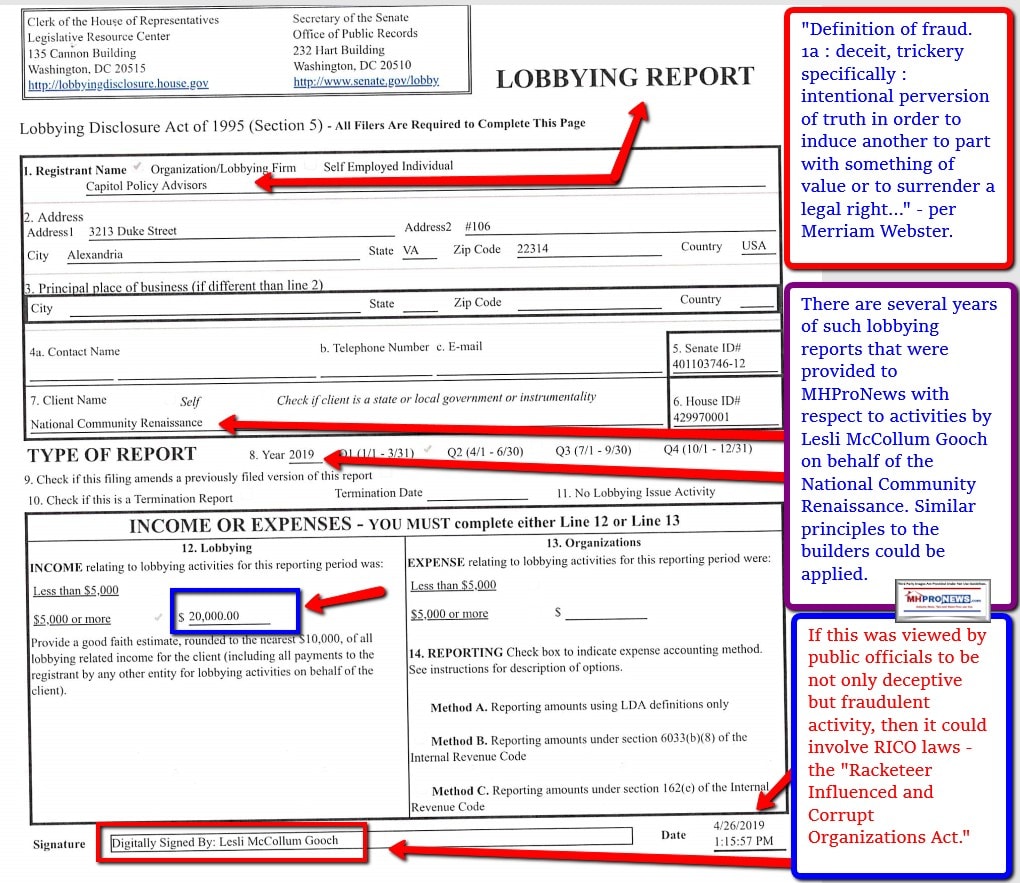
A longtime staffer at MHI told MHProNews that the above apparently documented conflicts of interest by Gooch with respect to her purported ‘advocacy’ for MHI and manufactured housing were known in their office by other staff members. Such details have been reported by MHProNews previously. See linked reports herein for more.
Note: to expand this image to a larger or full size, see the instructions
below the graphic below or click the image and follow the prompts.


As noted above and below, this is a developing story and more information and insights are planned for publication in the days ahead.
In fact, there is already more evidence in hand about ‘lady Gooch.’ It is apparent that a book could be written about that woman, some of which may seem odd, some seemingly impressive, but when more carefully examined, the evidence may reflect an individual who has rife with conflicts of interest that apparently MHI leaders know about. Which, of course, calls those leaders into question too. In a male dominated industry, Gooch is often hailed. But then, so too was Chimene van Gundy, until investors and federal officials filed suits and charges against her. Note that the report below has been among the more read items on MHProNews since it was posted. Is Gooch going to be revealed as a different version of fraud than that of Van Gundy?
Summing Up What Is Known. Apparent, and Still in Question
Gooch, some MHI linked attorneys, and the chair of MHI in the past few years, Leo Poggione, were among those contacted by MHProNews in prep for this report. The following was asked.
- Start date
- Invite to correct or respond to any recent or current MHProNews/MHLivingNews report.
A check of messages and phones reveals no apparent or known responses.
So, it is not entirely clear why there are differently reported years from various sources on Gooch’s start date and year. There is more on that which may may be the subject of follow up report by MHProNews.
But as was noted above, whether or not Gooch began work for MHI before or after the testimony of F.R. “Jayar” Daily to Congress, it is fair to surmise that an experienced, honest, and detail minded professional in her role should at a minimum have reviewed the work and status of those efforts. That would be especially true if there was any real or sincere desire on the part of MHI to do back then what they claimed they wanted to achieve.
There are some interesting details that have emerged or resurfaced about Richard “Dick” Jennison and Mark Bowersox during the course of this research. Jennison was MHI’s prior president and CEO. Bowersox is MHI’s president in the somewhat odd structure of splitting those two roles (often held by the same person in an organization such as MHI, as was true for Jennison, Gail Cardwell, Chris Stinebert, etc.). More on those topics is planned.




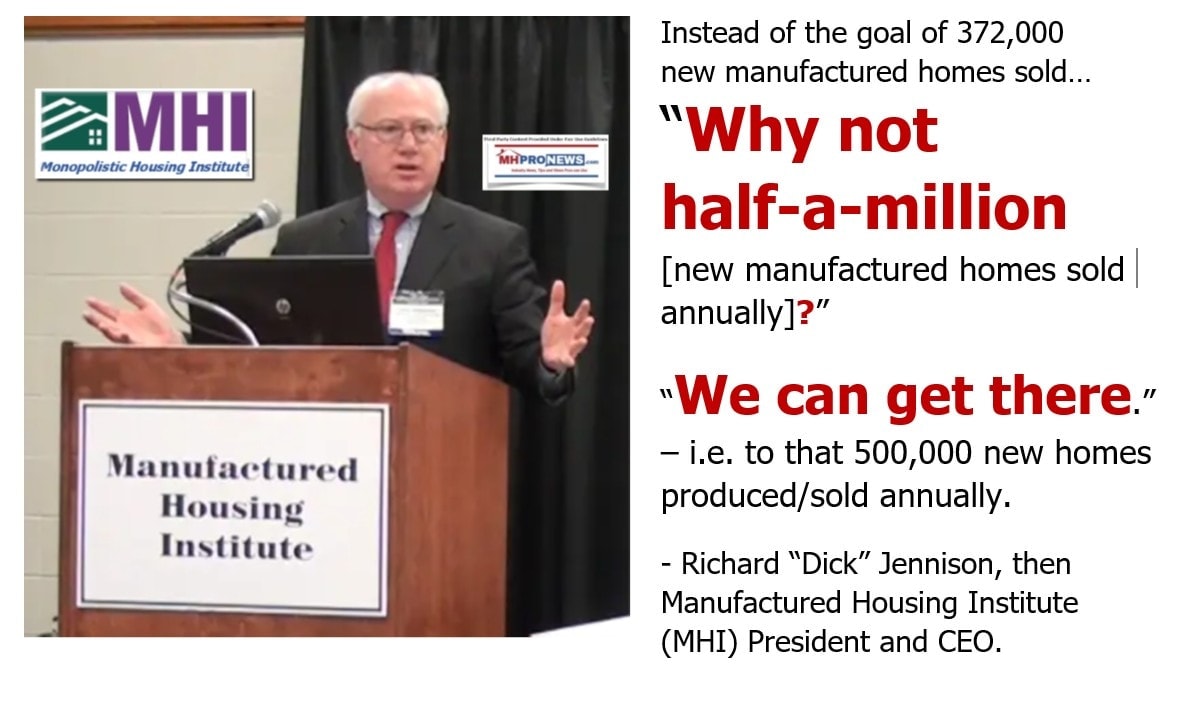

Legal Woes Loom and Mount for MHI, MHI Linked Members
As has been previously reported by MHProNews/MHLivingNews, there is now one big active antitrust suit that alleges collusion between several MHI members that violate antitrust laws.
There is also now another law firm that has announced a probe of several Manufactured Housing Institute (MHI) and/or MHI linked state associations. That will be the subject of a separate follow-up report, which may appear on the Masthead or Daily Business News on MHProNews soon. Stay tuned for that update.
According to the attorney asked by MHProNews, the DOE’s legal arguments have apparent weakness (see above). Will MHI’s attorneys handle those weaknesses properly? Or will MHI throw yet another lifeline to the DOE?
There is an ever-stronger evidence-based case to be made that MHI has arguably been corrupted and has not been acting in good faith with respect to consumers and independents or even the general reputation of the industry. Several concerns have been raised by MHARR on a different and/or related ways, but nevertheless routinely significant level.
Concerns have been raised by current and now former MHI members and MHI critics in the 21st century.
There are hints in the pleadings that other MHI members, and/or that MHI itself may become the subject of antitrust and possibly other legal suits or probes.
Newcomers should know and long time readers of this site should remember that MHProNews has sounded the warning that MHI’s antitrust document appears to be as much or more of a road map for what MHI linked firms and personalities have been doing for years. Restated, the MHI antitrust message may be window dressing.
An informed source linked to MHI has told MHProNews that notorious to numerous Havenpark Communities residents has separated from MHI membership. The reason(s) for that are not known. But if they have anything to do with the MHI/NCC so-called Code of Ethical Conduct, it may be a farce, comical, or a possible case of favoritism by MHI between firms of the same general category. To illustrate that point, one should dive into the report linked below.
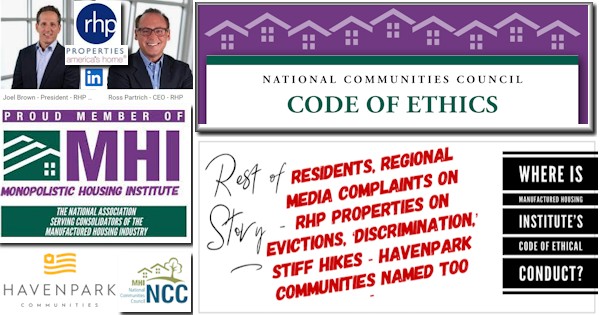
As MHProNews/MHLivingNews has previewed reported, MHI and/or its ‘consolidator-focused’ members have often been accused of predatory and market manipulating tactics. As supporters of a true free enterprise system that includes the rights, privileges, protections, and freedoms of a constitutional republic, it should be disclosed that MHProNews is not opposed to a given consolidation, acquisition, or merger per se. What is arguably erroneous is the goal of monopolization of a market in either a one dominant firm monopolization or via an oligopoly style of monopolization.
While we have editorially opposed in several of our remarks and analyses the Biden regime on several levels, in keeping with the principle of separation of the wheat from the chaff, it is fair to say that the Biden White House Fact Sheet on competition makes certain useful and evidence-based arguments about the possible harms caused by a lack of competition.

But one may give the Biden regime that nod while still pointing out that there has been a lot of thunder but not as much in the way of measurable results against those who focus on antitrust in the Biden era. Is antitrust serious for the Biden team? Is it merely a way of collecting fines (think revenue) and creating new regulatory-linked wrinkles for smaller firms to navigate? As big antitrust cases are developing or are underway, MHProNews plans to explore those in a fresh report in the days ahead. Prior reports and research into those issues are linked herein. But note for now that some of the antitrust efforts underway were launched while deposed President Donald J. Trump was in office. Again, stay tuned for more.
The Biden regime is increasingly being called out for its behaviors, policies, and purported corruption by some members and supporters of their own Democratic party. While Biden has announced for 2024, there are those within Democratic ranks who oppose his seeking a second term. There is concern that Biden-Harris may be a drag on down ballot races. MHProNews has reported on and will monitor such topics.
Vindicated! Summary and Interim Conclusions
MHProNews/MHLivingNews is to a significant degree being vindicated in its years of reporting, reviews of third-party research, and evidence-based concerns that MHI has become a corrupt institution used by a few larger members as a tool for consolidation that harms the interests of independents, consumers, taxpayers, shareholders, investors, and others.
In several ways, MHProNews stood alone and apart from other trade media and bloggers in the MHI orbit. While some curried MHI’s goodies and favors, MHProNews dared publicly question Gooch and Jennison years earlier based on evidence and suspicious behaviors.
That should be part of the job of authentic trade media. Who says? The principles laid out by the American Press Institute, as but one possible example.

The manufactured housing industry is underperforming. For thinking people, that begs the question why?
Some bloggers and trade publishers have dodged even mentioning the topic of declining sales and production in the last year, or in prior downturns. Not so with MHProNews/MHLivingNews. We put the facts out month by month, year by year. The facts, along with related expert commentary speak volumes.
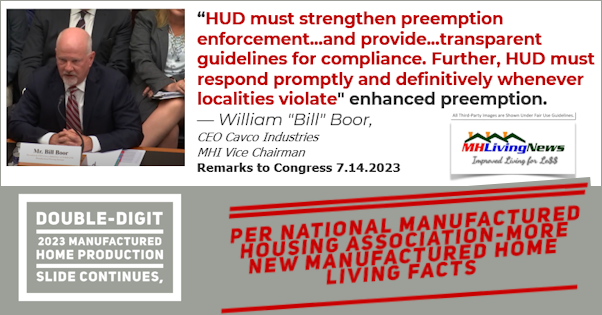
It is an open question why MHI has several window-dressing moves. The awards of MHI are, or should be, and embarrassment in several instances. How Flagship Communities or Cavco Industries (CVCO), for example, could get ‘excellence’ awards when they have problematic consumer, legal, and other issues is arguably either mystifying, bizarre, or corrupt, take your pick.
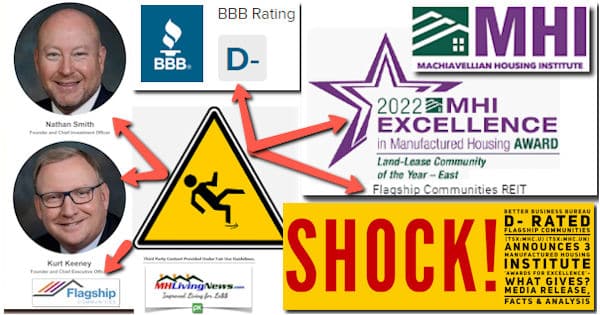



There is an evidence-based case to be made that the industry owes a debt of gratitude to MHARR for pressing and de facto pressuring MHI on several fronts, including the MHI suit vs. DOE.
Without straining to pat our own backs, it is fair to note that MHProNews presaged the current and developing legal issues months and years in advance. We began our critiques of MHI while this writer was on an MHI board, and our firm was an MHI member. There is no one else in MHVille that did more to explore and expose the concerns and seemingly contradictory and now perhaps apparently and appallingly corrupt behaviors at MHI. Several of those prior exposes are linked from the report below.
While Gooch, for instance, may have seemed like an upgrade at the time she came on board with MHI, in hindsight, she now appears to be more window dressing by MHI’s insiders. There appears to be several reasons why MHI’s leadership that hired Gooch should, in hindsight, be questioned.





By the standards set by then MHI president and CEO Richard “Dick” Jennison, that manufactured home production could be half a million (500,000) new HUD Code homes produced annually, the manufactured housing industry is doing poorly.


To hail lady Gooch as some kind of ‘nearly’ or ‘almost’ a person of influence is an arguably interesting, sometimes laughable, and apparently lesson in gaslighting. It only goes as evidence towards a case to be advanced that MHI is seemingly corrupt and/or incredible inept and is being run by corrupt and/or inept leaders. If someone says, rightly so, that MHI leaders are often educated and seasoned veterans in their field, then that is perhaps a reason to lean towards the notion that MHI has been corrupted. Which is part of what MHProNews/MHLivingNews have been exposing for the past several years – based on evidence, outcomes, and logic (or common sense).

While MHVillage and MHInsider – which are part of the Equity LifeStyle Properties (ELS) owned group brands linked to Datacomp that are being sued for possible antitrust and collusive illicit and/or illegal behavior – may understandably hail Gooch and MHI, why do some others among MHVille trade media and bloggers do so?

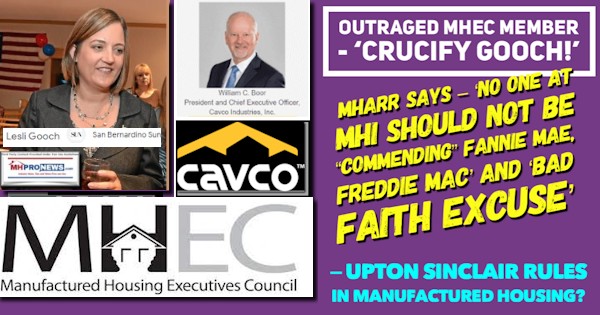
A series of illusions have been engineered in MHVille.

Some of those illusions arguably involve high profile firms and individuals, such as Kevin Clayton, Warren Buffet, Clayton Homes, 21st Mortgage Corporation, Vanderbilt Mortgage and Finance (VMF) and other firms, some of which have been named in the class action-antitrust suit. But other firms have not yet been named that arguably should be included in such legal efforts to clean up the corruption in manufactured housing.


It is that corruption which is arguably a key part of the authentic cause for the manufacturing housing industry’s problematic underperformance in the 21st century.
To learn more see the linked and related reports.
Watch for related follow-up reports on the new probe and other relevant subjects signaled above. They will include more information and evidence-based insights on MHI senior staffers Gooch, Bowersox, and Jennison.
There are pages of material on Gooch, much of which is apparently troubling. That is why a special follow up report is planned on Gooch. But until then, see the linked reports to get a broader understanding of the difference between the MHI ‘wow, what a great leader’ image vs. the more sobering and even troubling realities.
Then, there are pages of materials on MHI’s history on the DOE energy issue, again, much of which is problematic. There are also more to know about other topics that Jayar Daily dealt with, some of which has been concisely dealt with by MHARR President and CEO, Mark Weiss, in items like the one below.

As an important side note. MHProNews has periodically reminded readers that we don’t think there is evidence yet (or perhaps ever) that everyone at MHI is corrupt. Some MHI staff and members may be white hats swimming in a pool with a lot of apparent black hats in it. Restated, there are likely to be several white hat brands and individuals that have become entangled in the MHI web, for whatever reason(s).


Part III – is our Daily Business News on MHProNews stock market recap which features our business-daily at-a-glance update of over 2 dozen manufactured housing industry stocks.
This segment of the Daily Business News on MHProNews is the recap of yesterday evening’s market report, so that investors can see at glance the type of topics may have influenced other investors. Thus, our format includes our signature left (CNN Business) and right (Newsmax) ‘market moving’ headlines.
The macro market move graphics below provide context and comparisons for those invested in or tracking manufactured housing connected equities. Meaning, you can see ‘at a glance’ how manufactured housing connected firms do compared to other segments of the broader equities market.
In minutes a day readers can get a good sense of significant or major events while keeping up with the trends that are impacting manufactured housing connected investing.
Reminder: several of the graphics on MHProNews can be opened into a larger size. For instance: click the image and follow the prompts in your browser or device to OPEN In a New Window. Then, in several browsers/devices you can click the image and increase the size. Use the ‘x out’ (close window) escape or back key to return.
Headlines from left-of-center CNN Business – from the evening of 9.27.2023
- Oil surges above $94 a barrel for the first time in a year as stockpiles shrink
- Meta CEO Mark Zuckerberg unveils the Meta Quest 3 at Meta Connect in Menlo Park, California, on September 27, 2023.
- Zuckerberg unveils Quest 3 as Meta tries to stay ahead in the mixed reality headset game
- The Target logo is displayed on shopping carts outside of a Target store on January 15, 2020 in San Francisco, California.
- Target citing crime for closing stores shows retailers are fighting an uphill battle
- Members of the United Auto Workers (UAW) pickett outside of the Michigan Parts Assembly Plant in Wayne, Michigan amid rumors that US President Joe Biden may stop by during his visit to Michigan to stand on the pickett lines with UAW workers in Detroit, Michigan on September 26, 2023. Biden traveled to Michigan to lend his support to the striking UAW workers a day before former president Donald Trump was scheduled to visit and hold a rally for UAW workers.
- Autoworkers union may expand its strike again
- Back view of businesswoman looking through the window while relaxing with hands behind head in the office. Copy space.
- Why aren’t more women leading US companies? Americans weigh in
- The 2012 Hyundai Motor Co. Accent five-door hatchback stands in Las Vegas, Nevada, U.S., Thursday, June 16, 2011.
- In latest recall, Hyundai and Kia ask owners of 3.3 million vehicles to park outside due to risk of fire
- In this March 2018 photo, then-President Donald Trump speaks to a crowd gathered at the Local 18 Richfield Facility of the Operating Engineers Apprentice and Training, a union and apprentice training center specializing in the repair and operation of heavy equipment, in Richfield, Ohio.
- Trump claims to be pro-worker. His record says he’s anti-union
- In an aerial view, the Strategic Petroleum Reserve storage at the Bryan Mound site is seen on October 19, 2022 in Freeport, Texas.
- America’s emergency oil reserve is at a 40-year low — and that could inflate oil prices, Goldman Sachs says
- California-based EV maker Lucid opens first-ever auto plant in Saudi Arabia
- Panera, on a new TikTok fad-inspired menu, argues macaroni and cheese is iconic — much like the Roman Empire.
- Panera jumps on a TikTok trend, adds ‘Roman Empire’ inspired menu
- UBS shares rattled by report of US probe into Russia sanctions evasion
- Heinz creates ‘Ketchup and Seemingly Ranch’ condiment for Taylor Swift
- X has ditched a political misinformation reporting feature, researchers say
- What happens when gas is sold ‘at cost’? French drivers save pennies
- Dubai to start robotaxi trials next month in major autonomous push
- Gen Xers are next in line for retirement. Many haven’t saved nearly enough
- London is suffering an office ‘recession.’ Meta just paid $181 million to dump a lease
- Coal makes a quiet resurgence in the clean energy era
- Target says it will close nine stores in major cities across four states because of theft and organized crime
- Evergrande stock crashes again as fears of collapse grow
- Britain approves huge, controversial oil and gas field in the North Sea
- Culinary and Bartenders Unions in Las Vegas vote to authorize a strike
- Crisis at Evergrande deepens as it misses another bond payment
Note: to expand this image to a larger or full size, see the instructions
below the graphic below or click the image and follow the prompts.

Headlines from right-of-center Newsmax 9.27.2023
- WH Calls Biden Payment Revelations ‘Conspiracy’ Theory
- James Comer said Tuesday that President Joe Biden’s home in Wilmington, Delaware, was listed as the beneficiary address for two bank wires – payments to his son Hunter from Chinese nationals. [Full Story]
- Burlison: Joe Biden Was Hunter’s ‘Brand’
- Zinke: Ukraine Funded in Shutdown, but Not Us | video
- Judge Napolitano: Trump Ruling Could Alter NYC Real Estate | video
- Karen Pence: New Book Speaks About Faith, Service | video
- Fitzgerald: ‘Unbelievable’ Dems Skipped Chicago Hearing | video
- Mike Pence: Impeachment Inquiry ‘Appropriate’
- Lara Trump: Biden Hurts Unions on Immigration | video
- Tuberville: Will Keep Up Protest Against Wokeness in Military | video
- Johnson: Biden Using UAW for Photo Op | video
- Matt Schlapp: Biden Falls ‘Embarrassing’ for Family | video
- McFarland, Fleitz: Expect Mideast Nuke Arms Race | video
- Trump Lawyer: What’s the Point of N.Y. Trial After Ruling?
- Former President Donald Trump’s lead defense lawyer in the $250 million civil case brought by New York Attorney General Letitia James is asking what the point of a trial is after Tuesday’s ruling…. [Full Story] | video
- Related Stories
- Experts: Judge’s $18M Valuation of Mar-a-Lago ‘Delusional’
- Trump: ‘Deranged’ Judge ‘Railroaded This Fake Case’
- Napolitano to Newsmax: Trump Ruling Could Alter NYC Real Estate
- Trump: ‘Deranged’ Judge’s Ruling ‘Radical Attack’ On Me
- Judge Rules Trump Committed Fraud Amid Ex-President’s Denial
- Jim Jordan to Fani Willis: ‘Your Position Is Wrong’ on Request
- House Judiciary Committee Chair Jim Jordan Wednesday blasted Fulton [Full Story]
- Realtors: Mar-a-Lago’s $18M Valuation ‘Delusional’
- A New York judge’s lowball valuation for Donald Trump’s real estate [Full Story]
- Schumer: Won’t Ask Menendez to Resign
- Seante Majority Leader Chuck Schumer, D-N.Y., said Tuesday that he is [Full Story]
- House to Hold Hearing on Space Command HQ Move
- The House Committee on Armed Services is gearing up for a Thursday [Full Story]
- Biden Launches First Trump Attack Ad of 2024 Campaign
- President Joe Biden’s campaign this week released its first ad [Full Story]
- Dershowitz: Menendez Indictment Not Equal Justice
- Whether he stepped over the line will be determined by a jury after [Full Story]
- Related
- US Sen. Bob Menendez Pleads Not Guilty in Corruption Case
- Durbin, No. 2 Dem, Calls on Menendez to Resign
- Menendez Gets ‘Courtesy’ to Plead Case to Senate Dems
- C. Hits 200 Killings Before Oct., Highest Since ’97
- Washington, D.C., under Democrat control, has witnessed a surge in [Full Story]
- Wall Street Yo-Yos to a Mixed Close
- Wall Street yo-yoed to a mixed finish Wednesday as rising oil prices [Full Story]
- Bipartisan House Bill Protects Hunting Education Funds
- By a 424-1 margin, The House on Tuesday night approved the Protecting [Full Story]
- Obama Ally: Biden’s UAW Appearance ‘Outrageous’
- The head of former President Barack Obama’s auto industry task force [Full Story]
- Biden: Government Shutdown Not Inevitable
- President Joe Biden said on Wednesday that a government shutdown is [Full Story]
- Bank of America CEO: Fed Has Won Near-Term Battle Against Inflation
- The Federal Reserve has won the near-term battle against inflation, [Full Story]
- Winner Claims $1.6B Mega Millions Jackpot
- The winner of the $1.6 billion Mega Millions jackpot in August – the [Full Story]
- Canada’s Trudeau Apologizes After Nazi Veteran Was Praised in Parliament
- Canadian Prime Minister Justin Trudeau on Wednesday formally [Full Story]
- UAW to Announce Plans to Expand Strike on Friday
- The United Auto Workers union says it will announce on Friday how it [Full Story]
- Meta Unveils Facebook-Stream Ray-Bans, AI Assistant
- Meta Platforms Chief Executive Mark Zuckerberg Wednesday rolled out a [Full Story]
- Anti-Family Fare May Seal Disney’s Fate
- No one “dragged” Disney into the culture wars it dove in head first. [Full Story]
- Poll: Third of Saudis Want Business Ties With Israel
- Roughly one-third of Saudi Arabian citizens would approve of [Full Story]
- How Long Do US Government Shutdowns Last?
- The U.S. government may be just days away from a shutdown that could [Full Story] | Platinum Article
- Hyundai, Kia Recall 3.4 Million US Cars Due to Fire Risks
- Hyundai and Kia are recalling nearly 3.4 million vehicles in the U.S. [Full Story]
- China’s Evergrande Chairman Put Under Police Watch
- The chairman of China Evergrande Group has been placed under police [Full Story]
- Is Biden Giving False Assurances of Terrorism Safety?
- Biden administration pronouncements suggesting that terror groups [Full Story] | Platinum Article
- Ozzy Osbourne Wants to Record Album, Tour Again
- Iconic rocker Ozzy Osbourne is determined not to let his health [Full Story]
- Report: Russians Watching ‘Pirated’ Hollywood Hits
- Russians are breaking the law to watch hit Hollywood movies like [Full Story]
- Kaepernick Writes N.Y. Jets Seeking to Renew Career
- Quarterback Colin Kaepernick has written to the New York Jets in [Full Story]
- Bruce Springsteen Postpones 2023 Tour Dates
- Bruce Springsteen and the E Street Band’s 2023 tour will be postponed [Full Story]
- San Francisco Mayor: Drug Test Welfare Recipients
- San Francisco Mayor London Breed has released a proposal to have [Full Story]
- Biden Admin Accused of Funding Terror-Tied Group
- The Biden administration is funding an organization that [Full Story]
- GOP Rep. Scalise: My ‘Cancer Has Dropped Dramatically’
- House Majority Leader Steve Scalise, R-La., has greatly improved his [Full Story] | video
- WH Calls Biden Payment Revelations ‘Conspiracy’ Theory
- House Oversight Committee Chairman James Comer, R-Ky., got the [Full Story] | video
- Amazon Left Scrambling As Shoppers Find out About Secret Deals
- Online Shopping Tools
- More Newsfront
- Finance
- BofA CEO: Fed Has Won Near-Term Inflation Battle
- The Federal Reserve has won the near-term battle against inflation, but interest rates are likely to stay higher for longer, Bank of America’s CEO Brian Moynihan said Wednesday…. [Full Story]
- Late-Night TV Shows Return With Strike’s End
- Bankman-Fried May Wear Suits at Trial, Judge Rules
- Is the 2024 Subaru Crosstrek Better than Honda CR-V?
- US Sues eBay for Selling Polluting, Cancerous Products
- More Finance
- Health
- 8 Proven Strategies to Improve Your Memory
- 8 Proven Strategies to Improve Your Memory
- Your memory is like a muscle that can be trained to be fitter and stronger. In this fast-paced world, it’s easy to lose focus and become forgetful, which can be frustrating and annoying. By the age of 60, more than half of men and women have concerns over their memory. But…… [Full Story]
- Blocked Intestines Warning Added to Ozempic Label
- Fast-Acting Nasal Spray May Ease Rapid Heartbeat
- Nighttime Hot Flashes Linked to Alzheimer’s Risk
- Blue Light From Screens May Trigger Early Puberty
Note: to expand this image to a larger or full size, see the instructions
below the graphic below or click the image and follow the prompts.




